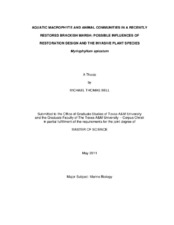| dc.description.abstract | The numerous benefits that wetlands provide make them essential to ecosystem services and ecological functions. Historically, wetland losses have been caused by natural and anthropogenic changes. In Texas, nearly 50% of coastal wetland habitat has been lost since the 1930s and losses in the Lower Neches watershed have been some of the most extensive. Restoration is a way to mitigate these losses and can be accomplished in many ways. Each restoration design creates different aquatic habitats that can influence both submerged aquatic vegetation (SAV) and faunal communities. The restoration of the Lower Neches Wildlife Management Area (LNWMA) has created the conditions for the growth of the invasive submerged macrophyte, Myriophyllum spicatum (Eurasian watermilfoil) which may be competing with the native aquatic grass, Ruppia maritima (widgeongrass) for essential nutrients. In this study, an attempt was made to link restoration design with both SAV and aquatic fauna community structures by using a throw trap to characterize assemblages observed in three different types of restored marshes. We also performed two controlled mesocosm experiments in 0.5 gal aquariums to determine growth inhibition by M. spicatum on R. maritima. Analyses using Kruskal-Wallis non-parametric test determined that temporal variations in fauna and SAV community composition was greater than any restoration effect. Discriminant Function Analyses (DFAs) determined two to three key faunal species that best predicted association among restoration designs, but linear regressions could not determine any consistent relationship between individual species density and biomass of the dominant SAV species, M. spicatum. For the mesocosm experiments, M. spicatum inhibited the biomass production and branch count of R. maritima when the two species are grown together (ANOVA, p = 0.004 and 0.003, respectively). Changes in SAV assemblages due to competition and habitat characteristics could play a major role in determining faunal community.
In order to minimize the temporal effect observed and better determine any habitat pattern that may be present, a much longer study is necessary. | en |


